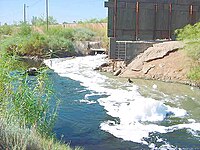
Photo from wikipedia
Per‐ and polyfluoroalkyl substances (PFAS) are widely used in commercial products such textiles, firefighting foams, and surface coatings across the globe and some PFAS are known to be bioaccumulative in… Click to show full abstract
Per‐ and polyfluoroalkyl substances (PFAS) are widely used in commercial products such textiles, firefighting foams, and surface coatings across the globe and some PFAS are known to be bioaccumulative in aquatic species. The ultimate sink for numerous anthropogenic chemicals is the sediments in lakes, rivers, and oceans. To understand the relationship between sediment and aquatic species, a literature search was performed and biota‐sediment accumulation factors (BSAFs) data for 17 taxonomic classes were assembled. The carbonyl and sulfonyl PFAS classes were relatively data rich whereas phosphate (no measurements), ether (one chemical), and fluorotelomer (limited number of chemicals) PFAS classes were data poor. Taxonomic classes of Teleostei and Clitellata had the largest BSAFs whereas Magnoliopsida and Bivalvia had the smallest BSAFs, and BSAF values >1 (kg‐OC/kg‐wet wt) were very rare. Across all studies, median (±standard deviation) whole‐body Teleostei BSAFs for perfluorooctane sulfonic acid and perfluorooctanoic acid (kg‐OC/kg‐wet wt) were 0.0580 (±0.445, n = 60) and 0.00283 (±0.103,24), respectively. Laboratory‐measured BSAFs were consistently larger than field‐measured BSAFs, that is, 53 of 67 comparisons were larger (80%). Comparing BSAFs across taxonomic classes, 72% of the BSAFs were significantly different (α = 0.05). Comparing BSAFs within a taxonomic class, BSAFs were significantly different for 63% of the taxonomic classes. Elimination kinetics for benthic invertebrates suggests steady‐state conditions might be reached in the 28‐day uptake portion of a laboratory bioaccumulation test for some test species. The largest data gaps, beyond limited measurements, are understanding the effects of concentration and mixtures on bioaccumulation from sediments, quantifying the difference, if any, in BSAFs between freshwater and brackish/marine ecosystems, and models for predicting BSAFs based on concentrations in sediment. Environ Toxicol Chem 2023;42:277–295. © 2022 SETAC. This article has been contributed to by U.S. Government employees and their work is in the public domain in the USA.
Journal Title: Environmental Toxicology and Chemistry
Year Published: 2022
Link to full text (if available)
Share on Social Media: Sign Up to like & get
recommendations!